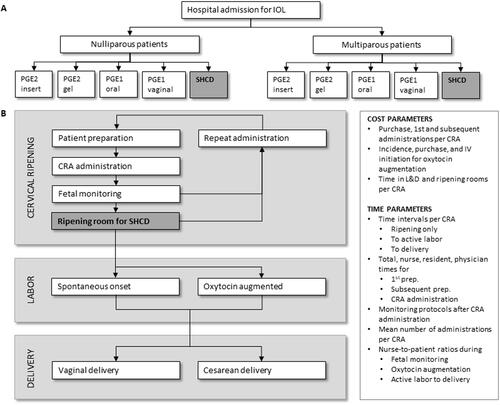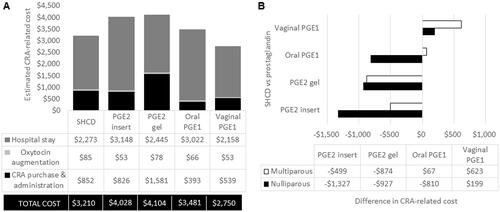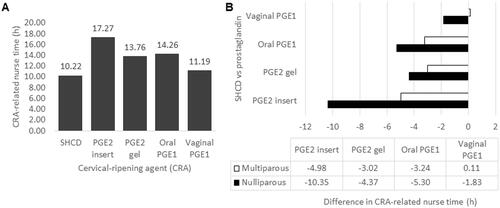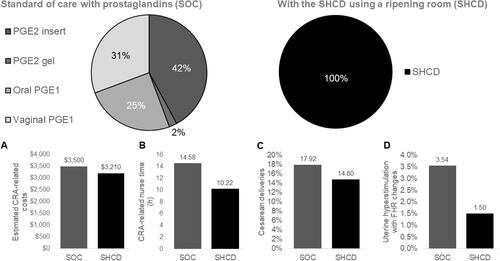Figures & data
Figure 1. Illustration of the cost-consequence model. (A) The decision tree for assigning a CRA. In the standard-of-care arm a prostaglandin is assigned and in the comparison arm the SHCD is assigned (grey box). A single patient receives only one type of CRA. Patients are modeled separately depending on their parity. (B) The process from admission to delivery is divided into a ripening, labor, and delivery phase. The ripening room (grey box) is a lower acuity room in comparison to an L&D room without facilities for fetal monitoring or for labor or delivery, and is only used in the model for patients undergoing cervical ripening with the SHCD. A cesarean section required prior to attempted labor was not modeled because it is expected to be rare in a patient population with low to moderate risk pregnancies and it would not change model outcomes. All other events (white boxes) occur in a standard L&D room. Key cost and time parameters are listed in the right-hand box. Abbreviations. CRA, cervical ripening agent; IV, intravenous; L&D, labor and delivery; PGE1, misoprostol; PGE2, dinoprostone; prep., patient preparation before CRA administration; SHCD, synthetic hygroscopic cervical dilator.

Table 1. Base-case cost parameters.
Table 2. Selected base-case parameters for population and IOL protocols.
Table 3. Overview of calculated CRA-related costs and consequences.
Figure 2. Estimated costs associated with the administration of each type of CRA based on an average US clinical practice for IOL. (A) Total CRA-related cost per CRA in the base case. (B) Cost difference when comparing the SHCD to each of the prostaglandins stratified by parity. The total estimated cost for the ripening room using SHCDs was $2,936 for multiparous and $3,647 for nulliparous patients using the base case for all other parameters. Abbreviations. CRA, cervical ripening agent; PGE1, misoprostol; PGE2, dinoprostone; SHCD, ripening room using the synthetic hygroscopic cervical dilator. Costs are given in 2020 USD.

Figure 3. Estimated nurse time associated with the administration of each type of CRA based on an average US clinical practice for IOL from admission to delivery. (A) Total CRA-related nurse time for each CRA in the base case. (B) Difference in nurse time when comparing the SHCD to each of the prostaglandins stratified by parity. The total nurse time for the SHCD was 9.13 h for multiparous and 11.98 h for nulliparous patients. Abbreviations. h, hours; PGE1, misoprostol; PGE2, dinoprostone; SHCD, ripening room using the synthetic hygroscopic cervical dilator.

Figure 4. Illustrating the impact of changing the cost of the ripening room proportionally to the L&D room cost when using the SHCD. The per-hour cost for the ripening room was tested from 10% to 100% of the L&D room (shown as a black line). The grey rectangle between 20% and 40% represents a reasonable cost range for the ripening room in comparison to the L&D room. For comparison, the prostaglandin costs are given as grey dots along the 100% line. If the patient remains in the L&D room and does not transfer to a ripening room, the maximum possible costs were $3,570 (at the 100% line in light grey), which $89 higher than the cost for oral PGE1. Costs are given in 2020 USD. Abbreviations. CRA, cervical ripening agent; L&D, labor and delivery; PGE1, misoprostol; PGE2, dinosprostone; SHCD, synthetic hygroscopic cervical dilator.

Figure 5. In scenario 2, we compared using a mix of prostaglandins in the standard of care (SOC) with switching to protocol including a ripening room and SHCDs. Comparisons are made in terms of (A) estimated CRA-related costs, (B) CRA-related nurse time, (C) cesarean deliveries, and (D) uterine deliveries with fetal-heart-rate (FHR) changes. The proportions used for the prostaglandins were taken from studies based on US patient dataCitation5,Citation32,Citation33. Costs are given in 2020 USD. Abbreviations. CRA, cervical ripening agent; PGE1, misoprostol; PGE2, dinosprostone; SHCD, synthetic hygroscopic cervical dilator.

Table 4. Sensitivity analyses for the base case and scenario 2 for costs and nurse time.
Figure 6. Ranking for each CRA separately when comparing (A) CRA-related costs and (B) nurse time in the sensitivity analysis. 2,000 parameter settings were tested and the output for each parameter set was the rank for each CRA from 1 (best) to 5 (worst). Abbreviations. CRA, cervical ripening agent; L&D, labor and delivery; PGE1, misoprostol; PGE2, dinosprostone; SHCD, synthetic hygroscopic cervical dilator.

